

The perils of cheap AC Adapters
Warning : contains scenes some engineers may find disturbing.
I recently picked up an AC adapter for a Dell laptop I bought on Ebay, as the original one supplied was the wrong model, and would not charge the battery.
However all was not as it seemed......
The Logo Looks real enough...
But I became suspicious of the "For Dell" wording, and
lack of Dell logo on the label - looking at a number of ebay listings of other PA-10
adapters, the logo is present on the labels. Some of the text on the label was also
unreadble due to poor printing.
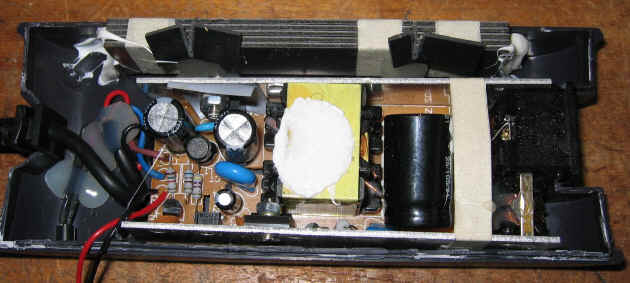 Opening it up reveals a rather smaller PSU board than expected,
plus a bundle of metal strips whose sole purpose is to add weight. Withou these the
unit feels very light and 'cheap'...
Opening it up reveals a rather smaller PSU board than expected,
plus a bundle of metal strips whose sole purpose is to add weight. Withou these the
unit feels very light and 'cheap'...
The plate rating of the PSU is 19.5V at 4.62A - 90 watts.
At 40x22x100mm, this is rather small to be a credible 90W supply, especially with the lack of any cooling arrangement to help conduct heat through the case.
On the underside, an apparently damaged track has been wired across,
however further inspection reveals that the track cut is intentional, as without it, the
input fuse would be bypassed..!
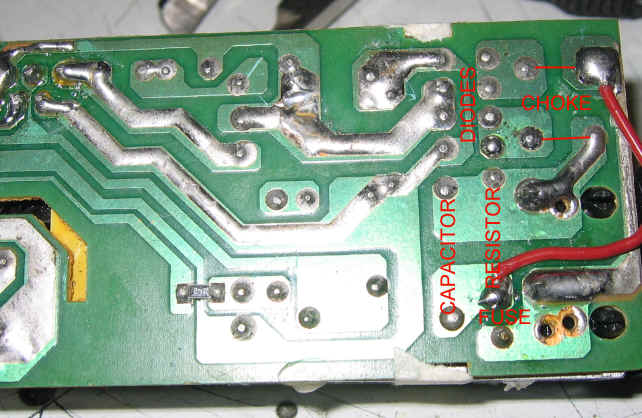 Detail of input circuitry - in its unmodified state, the fuse would only
protect the capacitor!
Detail of input circuitry - in its unmodified state, the fuse would only
protect the capacitor!
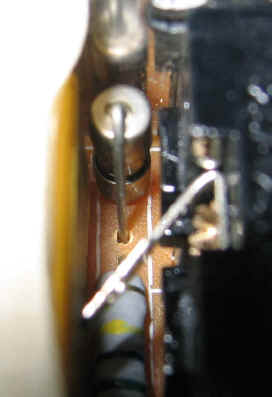 The fuse - this had a sleeve of heatshrink over it. However the
fuse itself is tiny, and I rather doubt it has a suitable breaking and clearance spec to
satisfy all the approvals marks on the label... The fuse is about 3.5mm dia x 12mm long.
The fuse - this had a sleeve of heatshrink over it. However the
fuse itself is tiny, and I rather doubt it has a suitable breaking and clearance spec to
satisfy all the approvals marks on the label... The fuse is about 3.5mm dia x 12mm long.
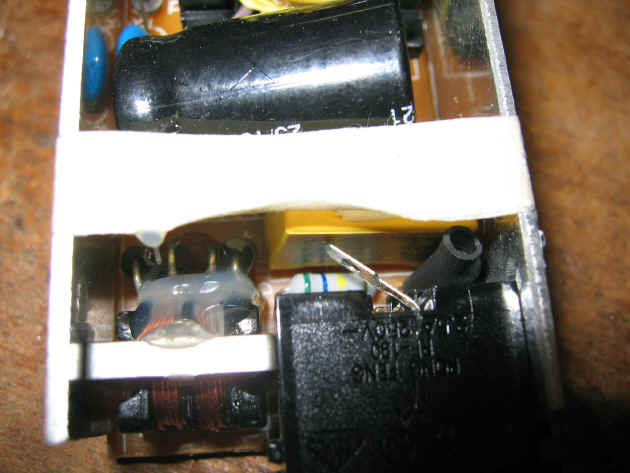 Although the mains connector is 3-pin, the earth pin is unconnected.
This would suggest that EMC filtering is not be as good as it should be. The reason that
most laptop AC adapters now have an earth pin is to enable interference suppression to the
level required by product standards worldwide.
Although the mains connector is 3-pin, the earth pin is unconnected.
This would suggest that EMC filtering is not be as good as it should be. The reason that
most laptop AC adapters now have an earth pin is to enable interference suppression to the
level required by product standards worldwide.
The filtering consists merely of a single X capacitor and a teeny little filter choke which hardly looks like being up to the job.
Now it just so happened that I was due to do some product testing at an EMC test house the following day, so I had the chance to do some measurements at a fully qualified test facility to confirm my suspicions.
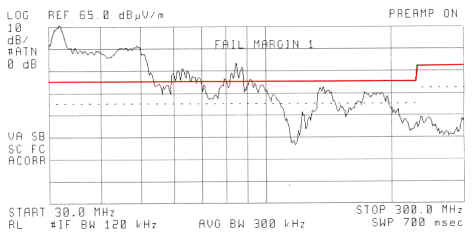 Result of radiated emissions test. This tests the amount of radio interference
transmitted in the range 30 to 300MHz.
Result of radiated emissions test. This tests the amount of radio interference
transmitted in the range 30 to 300MHz.
The red line shows the limit (EN61000-6-3 Class B radiated), below which all emissions must fall to be compliant for sale in Europe and bear the CE mark. Other countries' standards are similar if not identical.
Clearly a dismal failure, with peaks approaching 25dB over the limit line.
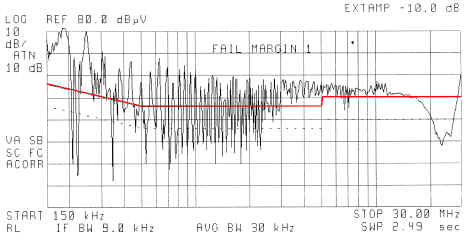 Result of conducted emissions test. This tests the amount of interference
transmitted down the mains lead, from 150KHz to 30MHz.
Result of conducted emissions test. This tests the amount of interference
transmitted down the mains lead, from 150KHz to 30MHz.
Similarly dismal results. The guy at the test house actually laughed when he saw the plot appearing on the EMC receiver... he'd never seen anything quite so bad..!
These results clearly show that the CE mark, and almost certainly all the other EMC
related approvals marks have been applied fraudulently.
I was surprised that when I tested its load capability, it did actually manage to put out its nameplate power rating. Regulation wasn't great but probably adequate :
| Load | Output voltage |
| No Load | 19.38V |
| 0.7A | 19.34V |
| 1.4A | 19.28V |
| 2.1A | 19.24V |
| 2.8A | 19.20V |
| 3.5A | 19.16V |
| 4.2A | 19.12V |
| 4.6A | 19.11V |
I ran it at 4.15A for half an hour, and measured the temperatures on the board using an IR thermometer. The highest value recorded was 75 degrees C. This is already rather high, but considering that this was with the case off, it would have been getting more airflow than it would with the case on. (And I don't think those lumps of metal would help much..!). I don't think it would last very long at full load... especially as hot-melt glue was used in several places to secure cables etc..
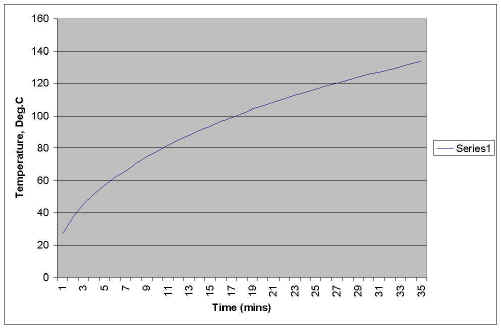 Feeling brave, I decided to run it at full load (4.6A)
with the cover on. This was measures with a thermocouple probe inside the case, with the
unit sitting on a flat surface.
Feeling brave, I decided to run it at full load (4.6A)
with the cover on. This was measures with a thermocouple probe inside the case, with the
unit sitting on a flat surface.
By 35 minutes, the internal temperature had reached a frightening 133 ºC! (271ºF).
I stopped there as I didn't want to fill the room with the pungent vapours produced by exploding electrolytic capacitors!
Immediately afterwards I opened the case and measured the case temperatures of the electrolytics - these varied from 100 to 120 ºC. As these caps are only rated for 105ºC they wouldn't have lasted too long..
Output voltage dropped about 1.5% during the test.